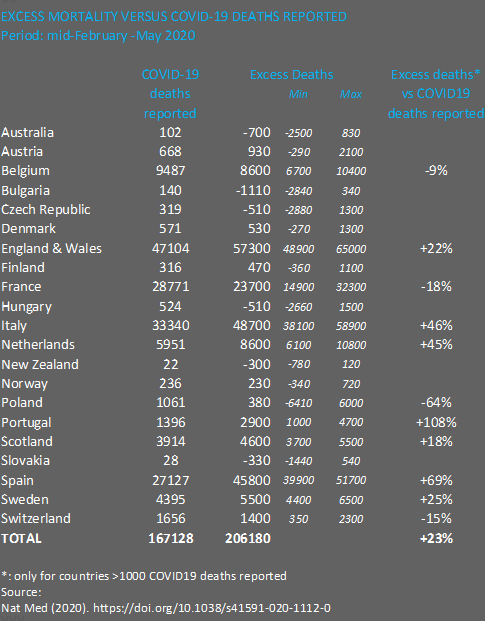Excess mortality and the COVID-19 pandemic
Countries struggle with reporting the numbers of people tested for COVID-19. But also getting the death toll right is far from trivial. This is why looking at excess mortality, regardless of causes, is a useful, independent alternative for assessing the pandemic death toll. Over the past months, data on this have been supplied by e.g. The Economist and Our World in Data.
A new study, now published in Nature, provides a rigorous, in-depth analysis. It has looked at 21 countries (19 in Europe, plus Australia and New Zealand) in the period mid-February until end of May.
The model was based on weekly mortality rates. By modeling death rates rather than the absolute number of deaths, effects of changes in population size or age distribution could be taken into account. The model included mortality data from 2010 until the start of the pandemic. It took into account how mortality in one week depends on preceding weeks, plus factors such as temperature variations throughout the year.
The number of excess deaths varied significantly between the 21 countries. Based on the effect found on excess mortalities, the authors divided the 21 countries in 4 groups:
Countries with no detectable rise of deaths: Bulgaria, New Zealand, Slovakia, Australia, Czech Republic, Hungary, Poland, Norway, Denmark and Finland.
Countries with a low effect (<10%): Austria, Switzerland and Portugal
Countries with a medium effect (10 – 25%): France, The Netherlands and Sweden
Countries with a large effect (25 – 40%): Belgium, Italy, Spain, Scotland, England & Wales.
Overall, the authors found an excess mortality of 206,000 (95% CI: 178,000 – 231,000) in the period commonly dubbed as the “first wave”. This difference might be due to undetected fatal infections and/or underreporting. Some increase of mortality could also be due to other diseases because of reduced care. Among the countries hardest hit by the pandemic (>1,000 deaths reported), Spain (+69%), Italy (+46%) and the Netherlands (+45%) show the largest difference between all-cause deaths and COVID-19 deaths. On the other hand, notably for Belgium and France the number of deaths assigned to COVID-19 was larger than the surplus.
The authors found that countries with more severe public health measures followed by fast implementation had less excess deaths. But this is no time yet to drop the guard. The Czech Republic, very successful in suppressing the pandemic during the first wave, experiences this the hard way. The country is currently faced with one of the most severe new outbreaks in Europe.

(rvdk)